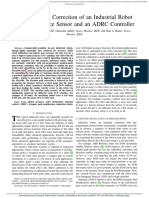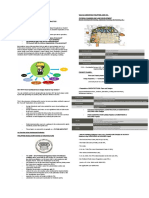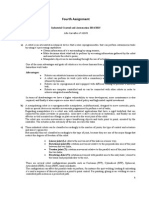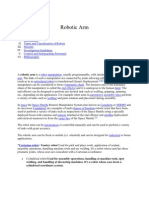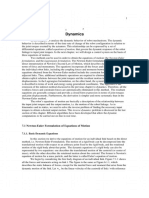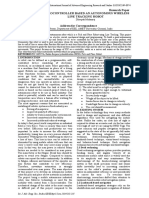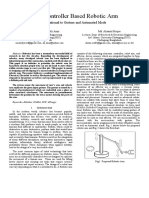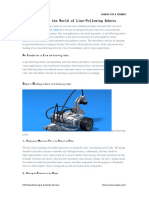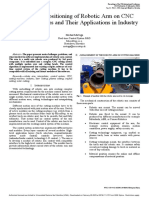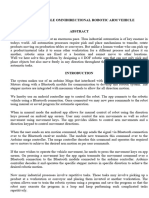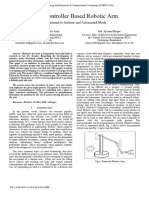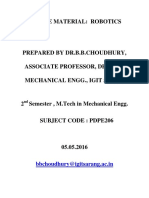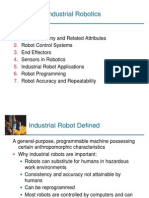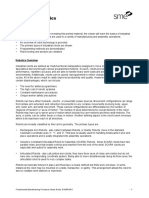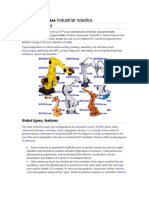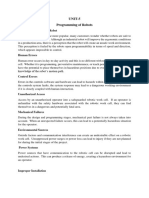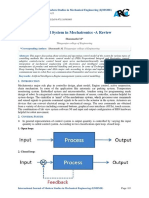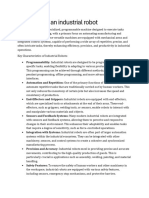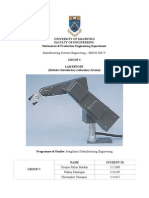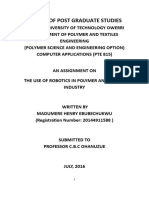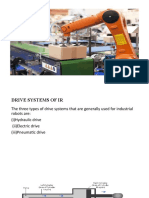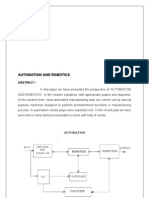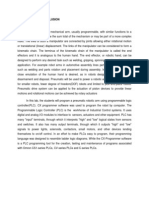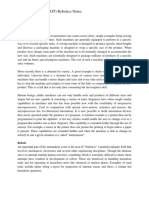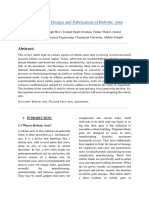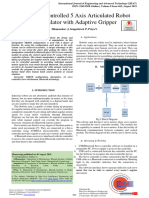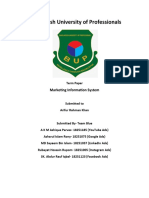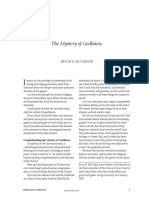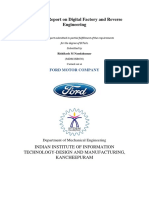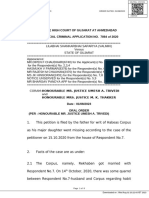Project Title...
Project Title...
Uploaded by
Abhishek ShahCopyright:
Available Formats
Project Title...
Project Title...
Uploaded by
Abhishek ShahOriginal Description:
Copyright
Available Formats
Share this document
Did you find this document useful?
Is this content inappropriate?
Copyright:
Available Formats
Project Title...
Project Title...
Uploaded by
Abhishek ShahCopyright:
Available Formats
PROJECT TITLE:
Micro controller based robotic arm for pick and place arrangement
INTRODUCTION:
Taking a look back at the history of robot development, a special kind of human-size industrial robotic arm called Programmable Universal Machine for Assembly ( PUMA) came into existence. This type of robot is often termed anthropomorphic because of the similarities between its structure and the human arm.. A robotic arm is a robotic manipulator, usually programmable, with similar functions to a human arm. The links of such a manipulator are connected by joints allowing either rotational motion (such as in an articulated robot) or translational (linear) displacement.The links of the manipulator can be considered to form a kinematic chain. The business end of the kinematic chain of the manipulator is called the end effector and it is analogous to the human hand. The end effector can be designed to perform any desired task such as welding, gripping, spinning etc., depending on the application. The function of the arm is to position and orient the hand, act as a mechanical connection and power and sensing transmission link between the hand and the main body of the person. For example robot arms in automotive assembly lines perform a variety of tasks such as welding and parts rotation and placement during assembly.
Micro-Controller:
A microcontroller is an entire computer manufactured on a single chip. Microcontrollers are usually dedicated devices embedded within an application e.g. as engine controllers in automobiles and as exposure and focus controllers in cameras. In order to serve these applications, they have a high concentration of on-chip facilities such as serial ports, parallel input/output ports, timers, counters, interrupt control, analog-to-digital converters, random access memory, read only memory, etc. The I/O, memory, and on-chip peripherals of a microcontroller are selected depending on the specifics of the target application. Since microcontrollers are powerful digital processors, the degree of control and programmability they provide significantly enhances the effectiveness of the application. Embedded control applications also distinguish the microcontroller from its relative, the general purpose microprocessor. Embedded systems often require real-time operation and multitasking capabilities. Real-time operation refers to the fact that the embedded controller must be able to receive and process the signals from its environment as they are received. Multitasking is the capability to perform many functions in a simultaneous or quasi-simultaneous manner
TYPES
AND
CLASSIFICATION
OF
ROBOTS:
Industrial robots are available commercially in a wide range of sizes, shapes, and configurations. They are designed and fabricated with different design configurations and a different number of axes or degrees of freedom. These factors of a robot's design influence its working envelope (the volume of working or reaching space). Diagrams of the different robot design configurations are shown in Figure
A. Servo and Nonservo All industrial robots are either servo or nonservo controlled. Servo robots are controlled through the use of sensors that continually monitor the robot's axes and associated components for position and velocity. This feedback is compared to pretaught information which has been programmed and stored in the robot's memory. Nonservo robots do not have the feedback capability, and their axes are controlled through a system of mechanical stops and limit switches.
B. Type of Path Generated.
Industrial robots can be programmed from a distance to perform their required and preprogrammed operations with different types of paths generated through different control techniques. The three different types of paths generated are Point-to-Point Path, Controlled Path, and Continuous Path. a. Point-to-Point Path. Robots programmed and controlled in this manner are programmed to move from one discrete point to another within the robot's working envelope. In the automatic mode of operation, the exact path taken by the robot will vary slightly due to variations in velocity, joint geometries, and point spatial locations. This difference in paths is difficult to predict and therefore can create a potential safety hazard to personnel and equipment.
b. Controlled Path. The path or mode of movement ensures that the end of the robot's arm will follow a predictable (controlled) path and orientation as the robot travels from point to point. The coordinate transformations required for this hardware management are calculated by the robot's control system computer. Observations that result from this type of programming are less likely to present a hazard to personnel and equipment. c. Continuous Path. A robot whose path is controlled by storing a large number or close succession of spatial points in memory during a teaching sequence is a continuous path controlled robot. During this time, and while the robot is being moved, the coordinate points in space of each axis are continually monitored on a fixed time base, e.g., 60 or more times per second, and placed into the control system's computer memory. When the robot is placed in the automatic mode of operation, the program is replayed from memory and a duplicate path is generated. C. Robot Components. Industrial robots have four major components: the mechanical unit, power source, control system, and tooling a. Mechanical Unit. The robot's manipulative arm is the mechanical unit. This mechanical unit is also comprised of a fabricated structural frame with provisions for supporting mechanical linkage and joints, guides, actuators (linear or rotary), control valves, and sensors. The physical dimensions, design, and weight-carrying ability depend on application requirements.design, and weight-carrying ability depend on application requirements.
INDUSTRIAL ROBOTS: MAJOR COMPONENTS
b. Power Sources A. Energy is provided to various robot actuators and their controllers as pneumatic, hydraulic, or electrical power. The robot's drives are usually mechanical combinations powered by these types of energy, and the selection is usually based upon application requirements. For example, pneumatic power (low-pressure air) is used generally for low weight carrying robots. B. Hydraulic power transmission (high-pressure oil) is usually used for medium to high force or weight applications, or where smoother motion control can be achieved than with pneumatics. Consideration should be given to potential hazards of fires from leaks if petroleum-based oils are used. C. Electrically powered robots are the most prevalent in industry. Either AC or DC electrical power is used to supply energy to electromechanical motor-driven actuating mechanisms and their respective control systems. Motion control is much better, and in an emergency an electrically powered robot can
be stopped or powered down more safely and faster than those with either pneumatic or hydraulic power.
D.Control Systems
1. Either auxiliary computers or embedded microprocessors are used for practically all control of industrial robots today. These perform all of the required computational functions as well as interface with and control associated sensors, grippers, tooling, and other associated peripheral equipment. The control system performs the necessary sequencing and memory functions for on-line sensing, branching, and integration of other equipment. Programming of the controllers can be done on-line or at remote off-line control stations with electronic data transfer of programs by cassette, floppy disc, or telephone modem. 2. Self-diagnostic capability for troubleshooting and maintenance greatly reduces robot system downtime. Some robot controllers have sufficient capacity, in terms of computational ability, memory capacity, and input-output capability to serve also as system controllers and handle many other machines and processes. Programming of robot controllers and systems has not been standardized by the robotics industry; therefore, the manufacturers use their own proprietary programming languages which require special training of personnel.
APPLICATIONS OF ROBOTIC ARM IN INDUSTRIES
Welding Applications y Arc Welding y Electron Beam y Flux Cored Welding y Mig Welding y Plasma Cutting y Plasma Welding Material Handling Applications y Dispensing y Injection Molding y Machine Loading y Machine Tending y Material Handling y Order Picking Resistance Welding Robot Laser Welding Spot Welding Tig Welding Welding Automation
y y y y y
y y y y y
Packaging Palletizing Part Transfer Pick and Place Press Tending
Other Applications y Bonding / Sealing y Cleanroom y Deburring y Drilling y Flame Spray y Foundry y Grinding y Material Removal
y y y y y y y
Milling Painting Automation Polishing Robotic Assembly Robotic Coating Thermal Spray Waterjet
You might also like
- Dynamic Path Correction of An Industrial Robot Using A Distance Sensor and An ADRC ControllerDocument11 pagesDynamic Path Correction of An Industrial Robot Using A Distance Sensor and An ADRC Controllergorka.sarabiaNo ratings yet
- Professional Practice 1Document31 pagesProfessional Practice 1Jan Gabriel CruzNo ratings yet
- Proposal Majlis Berbuka PuasaDocument4 pagesProposal Majlis Berbuka PuasaheryizwanNo ratings yet
- Industrial Robots and Robot System SafetyDocument19 pagesIndustrial Robots and Robot System Safetymaregu89No ratings yet
- Cai 4th PDFDocument3 pagesCai 4th PDFJoao CarvalhoNo ratings yet
- IESLCoE Robotics-Assignment - 2Document11 pagesIESLCoE Robotics-Assignment - 2kavish malakaNo ratings yet
- Robotic ArmDocument10 pagesRobotic ArmAhmed AliNo ratings yet
- 18BME025 - ME404 AssgnDocument13 pages18BME025 - ME404 AssgndevashNo ratings yet
- A253BB0FD2B6F79B35EC86FABEC2BDocument17 pagesA253BB0FD2B6F79B35EC86FABEC2BJuanDiegoReyesSanchezNo ratings yet
- Robot MechanismsDocument17 pagesRobot MechanismssnoozermanNo ratings yet
- RN Nptel RoboticsDocument13 pagesRN Nptel RoboticsmegaNo ratings yet
- Presentation Pick and Place Robo Arm 3d PrintedDocument16 pagesPresentation Pick and Place Robo Arm 3d PrintedKshitij BandarNo ratings yet
- 112638Document36 pages112638NANTHINI PRIYA J 215111073No ratings yet
- Introduction To ROBOTICSDocument25 pagesIntroduction To ROBOTICSNyandaMadili MalashiNo ratings yet
- Line Following Robot ResearchDocument4 pagesLine Following Robot ResearchtherealslimNo ratings yet
- Programmable 5 Axis Robotic Arm: Aug, 2008 ProjectDocument38 pagesProgrammable 5 Axis Robotic Arm: Aug, 2008 ProjectRehman ZahidNo ratings yet
- 1.1. A Sense of HistoryDocument8 pages1.1. A Sense of HistoryCarlitos FerNo ratings yet
- Pick and Place Robot Report New Edited2Document19 pagesPick and Place Robot Report New Edited2Kshitij BandarNo ratings yet
- Microcontroller Based Robotic ArmDocument5 pagesMicrocontroller Based Robotic Armনূর হোসেন সৌরভ0% (1)
- Exploring The World of Line-Following RobotsDocument5 pagesExploring The World of Line-Following RobotsjackNo ratings yet
- Control and Positioning of Robotic Arm On CNC Cutting Machines and Their Applications in IndustryDocument6 pagesControl and Positioning of Robotic Arm On CNC Cutting Machines and Their Applications in IndustryAndres Holguin RestrepoNo ratings yet
- B.E Mech Batchno 107Document57 pagesB.E Mech Batchno 107saravana murthyNo ratings yet
- Conferencepaper 2Document5 pagesConferencepaper 2Leo BoyNo ratings yet
- Robotics Note MDocument36 pagesRobotics Note MrajeshkunuNo ratings yet
- RoboticsDocument32 pagesRoboticsNimmagaddadeepakNo ratings yet
- CH 8 Industrial RoboticsDocument39 pagesCH 8 Industrial RoboticsDeepak PathakNo ratings yet
- Robotics & Automation by M. Sreenivasa ReddyDocument32 pagesRobotics & Automation by M. Sreenivasa ReddyVivek BhandarkarNo ratings yet
- DV04PUB11 Study GuideDocument5 pagesDV04PUB11 Study GuidetharNo ratings yet
- Metal Detecting RobotDocument51 pagesMetal Detecting RobotBariq MohammadNo ratings yet
- Project Report On "Industrial Automation": Submitted in Partial Fulfillment of The Requirement For The Degree ofDocument23 pagesProject Report On "Industrial Automation": Submitted in Partial Fulfillment of The Requirement For The Degree ofHarsha ShrivastavaNo ratings yet
- Automation and Robotics AssignmentDocument13 pagesAutomation and Robotics AssignmentMoHit LalNo ratings yet
- IME Module 5Document9 pagesIME Module 5balrambharath1236No ratings yet
- XXXXXXXXX (Title) : Submitted by Chaitanya Ranade 64Document12 pagesXXXXXXXXX (Title) : Submitted by Chaitanya Ranade 64HRITHIK POOJARYNo ratings yet
- Module 1Document6 pagesModule 1N BHUSHANNo ratings yet
- Exoskeleton FpgaDocument5 pagesExoskeleton Fpgachristian_chicomarNo ratings yet
- Robotics Unit-5 Question BankDocument6 pagesRobotics Unit-5 Question BankveerapandianNo ratings yet
- RoboticsDocument18 pagesRoboticslakshmigsr6610100% (1)
- Fundamental of Robotic ManipulatorDocument101 pagesFundamental of Robotic ManipulatorswapnakaleNo ratings yet
- Elements of Mechanical EngineeringDocument76 pagesElements of Mechanical EngineeringArjun Reddy NareddyNo ratings yet
- JournalDocument8 pagesJournalVarun SharmaNo ratings yet
- Industrial Robotics Industrial Robot: Pemda40Document8 pagesIndustrial Robotics Industrial Robot: Pemda40Sivakumar VedachalamNo ratings yet
- ESME Tadele B. Tuli and Tesfaye O. TerefeDocument9 pagesESME Tadele B. Tuli and Tesfaye O. TerefeTesfayeNo ratings yet
- Subsystems of Industrial Robots Include:: Module 1: Introduction To Robotics Lecture 2: Anatomy of Robots ObjectivesDocument3 pagesSubsystems of Industrial Robots Include:: Module 1: Introduction To Robotics Lecture 2: Anatomy of Robots ObjectivesSreekumar RajendrababuNo ratings yet
- Unit 5Document21 pagesUnit 5Sarika MadugulaNo ratings yet
- Colombo Et Al ISR-Robotik06Document12 pagesColombo Et Al ISR-Robotik06Ravikumar NagulaNo ratings yet
- Control System in Mechatronics - A Review: International Journal of Modern Studies in Mechanical Engineering (IJMSME)Document7 pagesControl System in Mechatronics - A Review: International Journal of Modern Studies in Mechanical Engineering (IJMSME)Ali EndrisNo ratings yet
- An Industrial Robot Is A SpecializedDocument10 pagesAn Industrial Robot Is A SpecializedAhmed anis GasmiNo ratings yet
- Robots IndDocument5 pagesRobots IndAhmed anis GasmiNo ratings yet
- AssignmentqDocument12 pagesAssignmentqDirajen PMNo ratings yet
- Mechanical Arm, Programmable, Arm Robot. Kinematic Chain. Endeffectors Hand. Automotiveassembly Lines Welding Bombdisarmament and DisposalDocument1 pageMechanical Arm, Programmable, Arm Robot. Kinematic Chain. Endeffectors Hand. Automotiveassembly Lines Welding Bombdisarmament and Disposalhakim rosthyNo ratings yet
- Henry RobotsDocument18 pagesHenry Robotshenry madumereNo ratings yet
- Lecture 4Document14 pagesLecture 4mahad adam OmariNo ratings yet
- Automation and RoboticsDocument9 pagesAutomation and Roboticschtanhull_1988No ratings yet
- DISCUSSION AND CONCLUSION Lab 2 PDFDocument2 pagesDISCUSSION AND CONCLUSION Lab 2 PDFImfarosha Emma60% (5)
- Unit 1 Fundamentals of RobotisDocument24 pagesUnit 1 Fundamentals of RobotisdeepakNo ratings yet
- Ijsred V5i3p21Document11 pagesIjsred V5i3p21Samuel AbraghamNo ratings yet
- Bluetooth Controlled 5 Axis Articulated Robot Manipulator With Adaptive GripperDocument5 pagesBluetooth Controlled 5 Axis Articulated Robot Manipulator With Adaptive Grippermb.farooqui02No ratings yet
- Chapter 2 SolutionDocument4 pagesChapter 2 SolutionEngr ShabirNo ratings yet
- Robotic Arm: Electronic & CommunicationDocument16 pagesRobotic Arm: Electronic & CommunicationDilipsinh DodiyaNo ratings yet
- Robotics Chapter 1Document11 pagesRobotics Chapter 1origafelixNo ratings yet
- BRE 501 Industrial RoboticsDocument26 pagesBRE 501 Industrial RoboticsakshaysinghNo ratings yet
- 35 Acid Base Equilibria: Calculating PH PH - Log (H)Document14 pages35 Acid Base Equilibria: Calculating PH PH - Log (H)Pedro Moreno de SouzaNo ratings yet
- (P) (Louca, 2003) The Concept and Instruction of MetacognitionDocument22 pages(P) (Louca, 2003) The Concept and Instruction of MetacognitionDũng LêNo ratings yet
- Ramirez Vs CADocument6 pagesRamirez Vs CAcharmssatellNo ratings yet
- Bangladesh University of Professionals: Marketing Information SystemDocument40 pagesBangladesh University of Professionals: Marketing Information SystemRakibNo ratings yet
- The Mystery of Godliness: Bruce R. McconkieDocument9 pagesThe Mystery of Godliness: Bruce R. McconkieLogan GracieuseNo ratings yet
- Dental Anatomy and PhysiologyDocument36 pagesDental Anatomy and PhysiologyCpt.WnchstrNo ratings yet
- Global Humanitarian Overview 2022 (Introduction)Document15 pagesGlobal Humanitarian Overview 2022 (Introduction)zeeshanNo ratings yet
- RTI 17 Mannual AO Estate A WardDocument21 pagesRTI 17 Mannual AO Estate A Wardsunilcharles2072No ratings yet
- Introduction To EDI and ALE:: AdvantagesDocument105 pagesIntroduction To EDI and ALE:: AdvantagesSrimannarayana KasthalaNo ratings yet
- Papua New Guinea Radiofrequency Spectrum Allocation Chart: VLF Legend VLFDocument1 pagePapua New Guinea Radiofrequency Spectrum Allocation Chart: VLF Legend VLFAidan MonaghanNo ratings yet
- Four Pillars of Cooperative GovernanceDocument4 pagesFour Pillars of Cooperative GovernanceriszkikaNo ratings yet
- Managerial AccountingDocument24 pagesManagerial AccountingLuân Châu100% (4)
- About Dementia RESEARCH - Well-Being Programming For PWD in Day Care Centres ReportDocument20 pagesAbout Dementia RESEARCH - Well-Being Programming For PWD in Day Care Centres ReportKarma SonamNo ratings yet
- Sant Mat Darshan Bhag 1Document456 pagesSant Mat Darshan Bhag 1Sant Mat60% (5)
- Internship Report 1Document30 pagesInternship Report 1Sayanth SunilNo ratings yet
- Presentation White Stock NewDocument12 pagesPresentation White Stock NewAshish Babu MathewNo ratings yet
- DMS Mircoproject FinalDocument22 pagesDMS Mircoproject FinalYash PhadolNo ratings yet
- From Inflammation To Sickness Historical PerspectiveDocument5 pagesFrom Inflammation To Sickness Historical PerspectiveВладимир ДружининNo ratings yet
- Lecture 8 - Bamboo As Construction Material PDFDocument33 pagesLecture 8 - Bamboo As Construction Material PDFVladimir SalamancaNo ratings yet
- The Independence ArgumentDocument120 pagesThe Independence Argumentronald youngNo ratings yet
- Vlplus 252 Influences Hattie Ranking Dec 2017Document2 pagesVlplus 252 Influences Hattie Ranking Dec 2017api-483011066No ratings yet
- The Wives of The Holy Prophet NotesDocument13 pagesThe Wives of The Holy Prophet NotesKPOPNo ratings yet
- HosmartAI OC2 - Annex 3.1 QRehab PT - Description of WorkDocument15 pagesHosmartAI OC2 - Annex 3.1 QRehab PT - Description of WorkvaheNo ratings yet
- The Dyslexic Reader 2008 - Issue 48Document28 pagesThe Dyslexic Reader 2008 - Issue 48Davis Dyslexia Association International100% (10)
- What Is Interprofessional Education?Document9 pagesWhat Is Interprofessional Education?ListrikawatiNo ratings yet
- TESDA Circular No. 004-2024Document72 pagesTESDA Circular No. 004-2024krishabellecenidozaNo ratings yet
- Neet 2020 Question PaperDocument44 pagesNeet 2020 Question PaperMANOJNo ratings yet
- Habeas Corpus 486285Document8 pagesHabeas Corpus 486285JbbNo ratings yet
